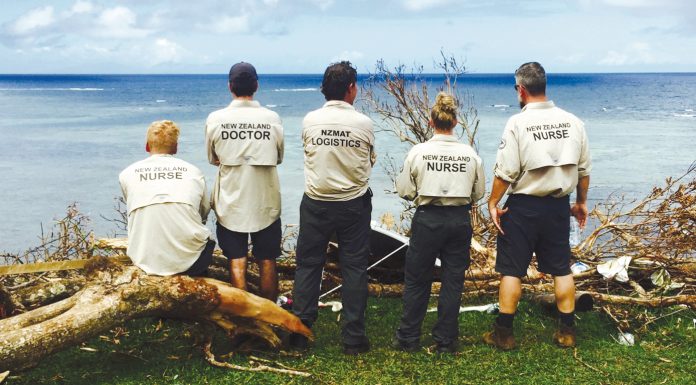Reading this article and undertaking the learning activity is equivalent to 60 minutes of professional development.
This learning activity is relevant to the Nursing Council competencies 1.4, 1.5, 2.1, 2.8, 3.1, 3.2 & 3.3. Discuss all your answers with a peer/s.
Learning outcomes
- increase your understanding of the experiences of individuals with aphasia
- reflect on factors within the health care environment that may negatively impact on communication with those individuals
- describe a range of nursing strategies to enhance communication with individuals experiencing aphasia.
Introduction
Before Ed was admitted to an aged residential care facility, he ran his own small but successful business, making the most of his gregarious personality to develop a loyal customer base. Following a serious stroke, he was wheelchair dependent, with little spoken language and mild difficulty processing the speech of others. (See box p.17)
Ed was reluctant to interact with other residents. He felt uncomfortable not being able to join in their conversations and mostly stayed in his room. Ed and I shared some common interests, and, as a staff member, I would visit him to talk about these.
I chatted, Ed laughed, occasionally cried, and sometimes used gestures to express his emotions. He spoke a few words – though his vocabulary was mostly limited to the words ‘yes’ or ‘no’, which were occasionally used appropriately, and a range of expletives.
I hoped that Ed enjoyed my visits but I also worried about whether what felt like such a one-sided exchange just added to his frustrations. Was there anything I could do differently as a nurse to enable Ed to participate more in these conversations?1
Aphasia is “an impairment of language, affecting the production or comprehension of speech and the ability to read and write”2. Aphasia is commonly categorised as either being expressive (knows what they want to say, difficulty with speech and writing), receptive (difficulty with understanding spoken or written words), or global (few recognisable words, understands little or no spoken language)2. There can be considerable variation, however, in which and how many aspects of communication are impaired, and the severity of symptoms (see box p. 17) and it is vital that staff who are working with these individuals are aware of which aspects of language have been affected.
Aphasia does not mean there has been a loss of intelligence, although this is often assumed. While aphasia can result from traumatic brain injury or disease processes such as tumours, the major cause is stroke2. Each year approximately 9,000 New Zealanders experience a stroke, a quarter of whom will be under 65 years old3. Between 25 and 33 per cent of stroke survivors will have some degree of aphasia4,5, with only about 40 per cent having made a complete or nearly complete recovery from their aphasia one year post-stroke6. Recovery may continue over a period of years, although it is likely to be slow and variable. It is estimated that there are 16,000 New Zealanders living with stroke-acquired aphasia5.
Other acquired conditions also impact on communication. These include two motor speech disorders – apraxia (difficulty initiating and executing voluntary movement patterns necessary to produce speech when there is no paralysis or weakness of speech muscles)7 and dysarthria (impaired movement of the muscles used for speech production)8. Apraxia often occurs alongside aphasia (the impaired ability to use or understand language), but this article focuses specifically on aphasia. Of course, many of the communication strategies discussed later will be relevant to all three conditions. Nurses working in aged residential care are more likely to come into regular contact with people with aphasia, but these individuals may be encountered in almost any health care setting.
Social isolation and frustration
Aphasia is more than just difficulty producing or processing language. It’s also about the impact on the individual’s sense of self, relationships with friends and family or whānau, and has to be understood within a wider cultural and social context. Experiences of aphasia that include communication difficulties and the associated frustration, social isolation and depression can’t be separated from the overall impact of the stroke. ‘Ed’ (see introduction) not only lost his speech, but his identity and place in the world9 as well as experiencing significant physical disabilities. He also had no option but to accept admission to aged residential care.
Aphasia can be socially isolating, and the source of much frustration. Tom Gilbert, an American physician, describes the impact of his post-stroke aphasia:
As my recovery progressed, I became aware of how isolated I had become. My inability to process information at a normal speed meant that I had difficulty following conversations and responding in an appropriate manner. My limited speech made it extraordinarily challenging to communicate. For example, my observation that Peggy’s car inspection sticker had expired resulted in 20 minutes of gestures and ’yes‘ and ’no‘ responses before she understood my point. Multiply this exchange by hundreds throughout the day to understand my exhaustion, frustration, and depression. It seemed that my former self was alive and well in a maze inside my brain, leaving only a simpler version of Tom communicating with the outside world10 (p. 202).
While the changes were profound for Tom, his wife also went from being an equal partner to needing to take charge, including making medical decisions for Tom. She also had to assume power of attorney for him.
While family or whānau experience major disruptions in their relationships with a person following a stroke and the development of aphasia, cultural support and social networks can counter some of the impacts of aphasia. Participants in New Zealand research into Māori experiences of aphasia highlighted the centrality of language to all aspects of their world, meaning the loss of language could be considered tragic11.
Both the individuals and their whānau keenly felt the loss of social roles associated with the aphasia, although considerable effort was expended by whānau to ensure the individual’s status was unaffected. While individuals with aphasia in that study experienced negative emotions associated with their condition, they were also able to ‘count their blessings’ because they were grateful for what they still had and were aware it could have been far worse.
Challenges in nursing individuals with aphasia
Nurses are required to communicate effectively with their clients12. Achieving two-way communication may be problematic when language is disrupted, giving rise to feelings of hopelessness and frustration for both the individual and the nurse13.
There are many factors that have the potential to result in challenges for nurses working with people with aphasia. Workload demands can impact on the time available to communicate with individuals, and nurses may also lack the knowledge, skills and confidence associated with facilitating conversations when aphasia is present.
Research has shown that even on specialist stroke wards, nurses engage in nurse-dominated conversations with patients that are largely focused on the nurses’ goals, with more than 54 per cent of interactions related to nursing tasks13. Communication enables the transfer of information, but is also fundamental to the development of social relationships, so essential for safe nursing practice14.
Each practice context presents its own challenges for nurses working with individuals with aphasia. In aged residential care, for example, challenges may include staff turnover, the high proportion of care being delivered by unregulated caregivers, the complexity of other co-morbidities the resident may be experiencing, restricted educational opportunities for staff, and limited access to other health professionals15. Having to communicate with staff for whom English is a second language may also be an additional barrier for residents. Residents’ access to speech-language therapists can also be erratic following the initial rehabilitation period.
Enhancing communication
There is no magic bullet for nurses who wish to improve their communication with individuals with aphasia, in part because of the diversity, extent and combination of symptoms. A broad approach is required, including supporting the person to develop a new sense of self and identifying how best to manage the time pressures associated with nursing workloads. Nurses may also require education on various communication principles/tips, and how to implement these.
Telling our stories (narrative) is an important component of all our lives – helping us to make sense of our world, and who we are within that world. When a person’s sense of self is dramatically disrupted by experiences such as post-stroke aphasia, narrative becomes even more important in helping reconnections between life as it is now and life before the stroke.
Narratives are also a valuable source of service feedback for health care providers14. Hersh14 promotes the need for nurses to become ‘conversation partners’, who can “… assume an active role in supporting, co-constructing and valuing these narratives” (p. 231).
Getting to know the person first, understanding their history and interests, enables new or modified goals to be identified7. Family may be able to provide information to support biographical connections, but nurses should be mindful that individuals and their families or whānau could have different perspectives and understanding of what was important and meaningful.
Nurses may need to seek further education on how best to manage their interactions with individuals with aphasia, such as how to deal with hesitations and silences13. Reflection on and reframing of workload demands is also necessary if appropriate time is to be allocated to ‘getting to know’ the person with aphasia. Hemsley et al16 explored the barriers to and strategies for successful communication between hospital-based nurses and patients with complex communication needs. Nurses who felt time-pressured because of demanding workloads avoided direct interactions with patients and relied instead on communication with family or paid carers.
Perceptions that communication difficulties may reflect intellectual disability, even when that is not the case, also discouraged nurses from investing time into communicating with the patient.
Conversely, in the same study, there were nurses who took the time to understand the patient’s point of view, were prepared to use a range of adaptive strategies to facilitate communication, and were open to the potential success of that communication. As those nurses noted, ‘being patient’ not only enhances wellbeing for the patient but also saves time in the long run. Communication becomes easier with the passage of time, and the nurses became more familiar with non-verbal expressions and responses.
When individuals with aphasia are transferred to aged residential care facilities from a stroke unit, nurses should ensure they access any communication books or strategies initiated by speech and language therapists for that individual.
Numerous websites contain ‘communication tips’ for working with individuals experiencing aphasia. Many of these tips, such as not talking over the person, should be fundamental communication practices; however, a reminder is always useful. Common suggestions include:
- Minimise background noise.
- Speak clearly and not too quickly.
- Listen attentively.
- Use short, clear sentences, giving one piece of information at a time.
- Clarify and rephrase when necessary.
- Take time to allow the person to respond, and time for rests if necessary.
- Use facial expression, tone of voice, and gestures to explain.
- Encourage the person to let you know when they haven’t understood.
- Have pen and paper available for both parties.
- Write down key words.
- Ensure appropriate communication devices and material are available (i.e. applications on electronic devices, individualised picture books and alphabet boards).
(adapted from Aphasia Alliance17)
Box 1
The range of aphasia symptoms
“Aphasia can be so severe as to make communication with the patient almost impossible, or it can be very mild. It may affect mainly a single aspect of language use, such as the ability to retrieve the names of objects, or the ability to put words together into sentences, or the ability to read. More commonly, however, multiple aspects of communication are impaired, while some channels remain accessible for a limited exchange of information.”
National Aphasia Association2
Conclusion
For some individuals who develop aphasia, the experience may be temporary or of minor consequence. For others the impacts of aphasia can be profound, both for the person themselves, but also their wider family or whānau. As with any major disruption to health status, lives are rewritten and new ways of being must be developed. Skilled and compassionate nursing can help those affected regain communication skills and a new place in the world.
View PDF of this learning activity here >>
Recommended resources
- The Aphasia Simulations website includes a useful overview of aphasia, communication tips, and a number of short simulations that provide a sense of what a person with aphasia may be experiencing. http://aphasiacorner.com/aphasia-simulations/index.html
- The Tavistock Trust for Aphasia website contains links to a range of resource information, including information on finding assistive technologies for people with aphasia. www.aphasiatavistocktrust.org/aphasia/what-is-aphasia
- Krishna Pindolas’s blog ‘My battle against my stroke’ describes her experiences, which included aphasia, after a stroke at the age of 18. http://strokerecoverybc.ca/newsletter/battle-stroke-krishna-pindolias-blog
- If you would like to know more about the different types of aphasia, check out aphasia definitions on the National Aphasia Association’s website www.aphasia.org/aphasia-definitions. The association has also produced an 18-minute video entitled ‘Patience, communication and understanding’ (2013). This provides a moving insight into the experiences of a small group of adults with a range of aphasia symptoms and includes strategies to aid effective communication. www.youtube.com/watch?v=aPTTjRTmgq0
- Hersh (2012, full details in reference 14) provides several interesting examples (for example, p. 227) of how an expert communicator can facilitate explicit narratives with individuals with aphasia.
- There are numerous videos on YouTube of experiences of aphasia, such as a series of videos made over a six-year period by Sarah Scott, who developed expressive aphasia after a stroke when she was 18 years old. This is the link to the first of her videos: www.youtube.com/watch?v=1aplTvEQ6ew.
About the authors
- Marian Bland RN PhD is the quality coordinator at Ranfurly Residential Care Centre, Feilding and a health care auditor.
- Lesley Batten RN PhD is a senior researcher at Massey University, Palmerston North.
This article was peer reviewed by:
- Julia Slark RN PhD, senior lecturer at the University of Auckland
- Olivia Browne RN, stroke clinical nurse specialist at Hutt Valley District Health Board
References
- Personal anecdote of MB
- NATIONAL APHASIA ASSOCIATION (n.d.) Aphasia definitions www.aphasia.org/aphasia-definitions
- STROKE FOUNDATION OF NEW ZEALAND (N.D.) Facts and fallacies. www.stroke.org.nz/stroke-facts-and-fallacies
- STROKE RECOVERY ASSOCIATION OF BRITISH COLUMBIA (2017) Learn more about aphasia.
http://strokerecoverybc.ca/7-steps-guide/aphasia-guide/ - APHASIA NZ CHARITABLE TRUST (2010) Aphasia facts. www.aphasia.org.nz/public/about/public-about
- POSLAWSKY I, SCHUURMANS, M, LINDEMAN E & HAFSTEINSDOTTIR T (2010) A systematic review of nursing rehabilitation of stroke patients with aphasia. Journal of Clinical Nursing 19, 17-32.
- AMERICAN HEART ASSOCIATION/AMERICAN STROKE ASSOCIATION (2013). Aphasia vs apraxia. http://goo.gl/1mMnRY
- AMERICAN SPEECH-LANGUAGE ASSOCIATION (2016) Dysarthria. www.asha.org/public/speech/disorders/dysarthria
- THOMPSON J & MCKEEVER M (2012) The impact of stroke aphasia on health and well-being and appropriate nursing interventions: An exploration using the Theory of Human Scale Development. Journal of Clinical Nursing 23, 410-420.
- GILBERT T, GILBERT M, CULPEPPER L & WILKINSON, J (2013) Voices of recovery: A family physician’s experience of aphasia. Family Medicine 45(3), 201-204.
- MCLELLAN K, MCCANN C, WORRALL L & HARTWOOD M (2014). “For Māori, language is precious. And without it we are a bit lost”: Māori experiences of aphasia. Aphasiology 28(4) 453-470.
- NURSING COUNCIL OF NEW ZEALAND (2012) Competencies for registered nurses. Retrieved January 2016 from www.nursingcouncil.org.nz/Publications/Standards-and-guidelines-for-nurses
- GORDON C, ELLIS-HILL C & ASHBURN A (2009) The use of conversational analysis: Nurse-patient interaction in communication disability after stroke. Journal of Advanced Nursing 65(3) 544-553.
- HERSH D (2015) “Hopeless, sorry, hopeless”: Co-constructing narratives of care with people who have aphasia post-stroke. Topics In Language Disorders 35(3), 219-236.
- CARRYER J, HANSEN C & BLAKELY J (2010) Experiences of nursing in older care facilities in New Zealand. Australian Health Review 34, 11-17.
- HEMSLEY B, BALANDIN S & WORRALL L (2011) Nursing the patient with complex communication needs: Time as a barrier and a facilitator to successful communication in hospital. Journal of Advanced Nursing 68(1) 116-126.
- APHASIA ALLIANCE (2014) Top tips for ‘Aphasia Friendlier’ communication. Retrieved on 26 March 2016 from www.aphasiaalliance.org/top-tips






















